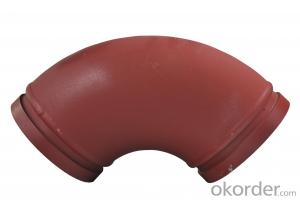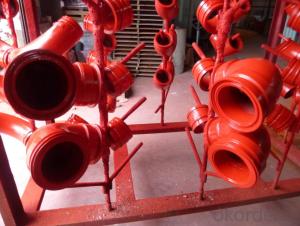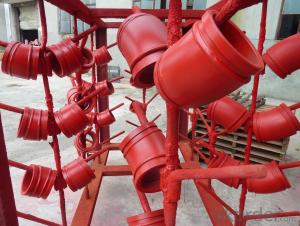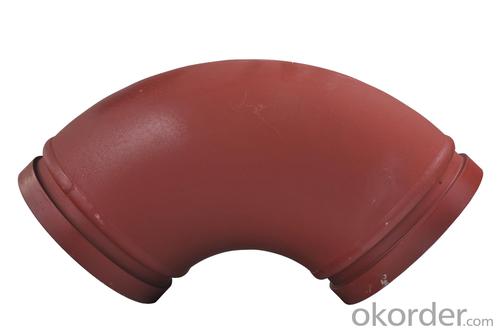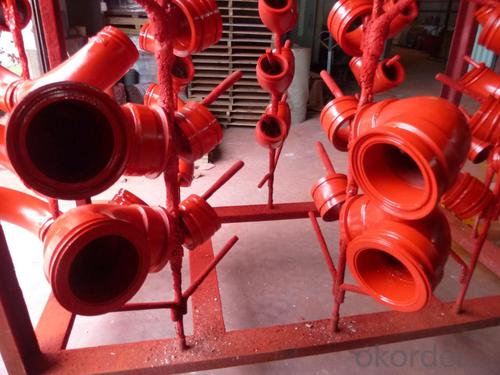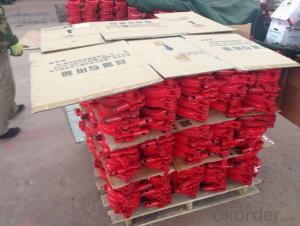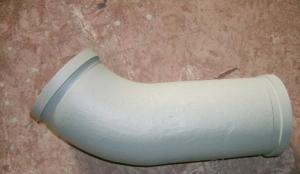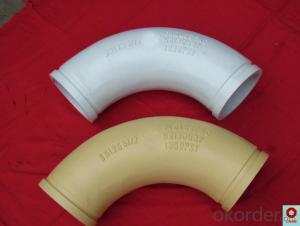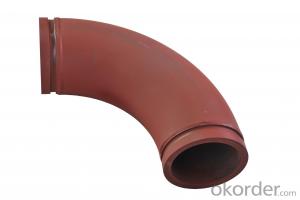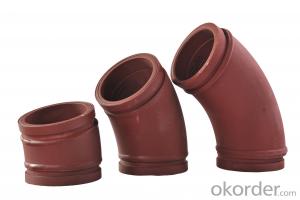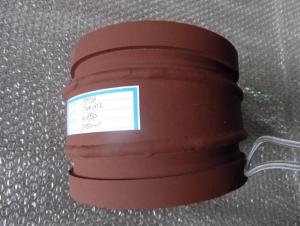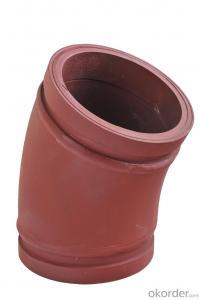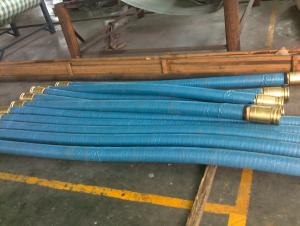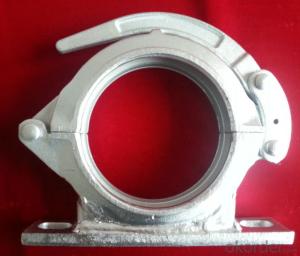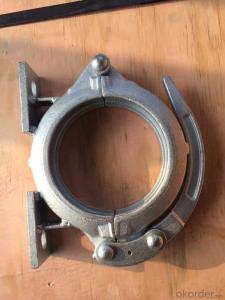Twin Wall Elbow for Concrete Pump R180 90DGR
- Loading Port:
- Tianjin
- Payment Terms:
- TT or LC
- Min Order Qty:
- 50 pc
- Supply Capability:
- 3000 pc/month
OKorder Service Pledge
OKorder Financial Service
You Might Also Like
Product Description:
Product Name: Twin Wall Pipe for Concrete Pump Pipe
Specification
(1) Material: Q235 (outside) + GCr15(inside)
(2) Thickness: 3mm (outside) + 9mm (inside)
(3) Technology: Quenching under high temperature
(4) Characteristics: the inner rigidity to 63 HRC; the outside has so high toughness to keep the inner.
(5) Matched with: Twin wall flange, Alloy (GCr15) + 20#
(6) Working Pressure:170bar
(7) Service life: above 60,000 cubic meters.
(8) Package: PP woven bag and plastic cap
3. Application
Concrete delivery.
4. Package
Put into containers.
FAQ:
Q1: Why buy Materials & Equipment from OKorder.com?
A1: All products have its ISO certifications, adheres to the highest standards and a commitment to supply chain safety and customer satisfaction.
Q2: How do we guarantee the quality of our products?
A2: We have established an advanced quality management system which conducts strict quality tests at every step, from raw materials to the final product. At the same time, we provide extensive follow-up service assurances as required.
Q3: How soon can we receive the product after purchase?
A3: Within three days of placing an order, we will begin production. The specific shipping date is dependent upon international and government factors, but is typically 10 to 30 workdays.
Q4: If we can produce Twin Wall Pipe for Concrete Pump Pipe Thickness 4.5mm Length 3000mm according to customers request?
A4: Yes, we can produce T Twin Wall Pipe for Concrete Pump Pipe Thickness 4.5mm Length 3000mm according to the difference country situations to make it suitable to the market and customers. We have very professional technical team to make the design.
Q5: How to make a quick resolution for after service?
A5: We have overseas branches all-around of world, If needed, the seller shall dispatch 2 engineers to the buyer's site for supervision of training. The buyer shall make available of necessary facilities &skilled personnel at site for training.
Images:
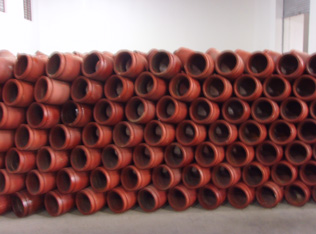
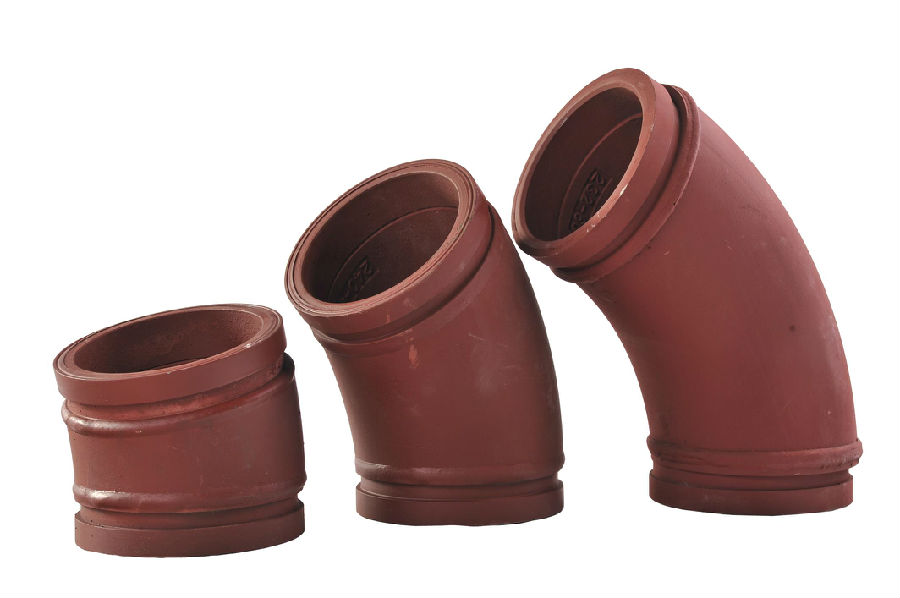
- Q: Can concrete pump spare parts be coated with anti-corrosion or anti-wear coatings?
- Certainly, it is possible to apply anti-corrosion or anti-wear coatings to concrete pump spare parts. These coatings serve as an extra protective layer, effectively shielding the spare parts from corrosion and wear caused by the tough operating conditions and abrasive substances encountered during concrete pumping. Usually composed of materials like epoxy, polyurethane, or ceramic, these coatings boast exceptional resistance against corrosion and wear. By applying these coatings, the lifespan of concrete pump spare parts can be significantly prolonged, consequently reducing the need for frequent replacements and resulting in cost savings for operators. Furthermore, the presence of anti-corrosion and anti-wear coatings can enhance the overall performance and efficiency of the concrete pump, ensuring smooth and dependable operation.
- Q: How can a faulty filter affect the pumping process?
- The pumping process can be significantly affected by a faulty filter in various ways. To begin with, the flow of fluid through the pump may be hindered if the filter becomes clogged or blocked. This can lead to reduced efficiency and increased energy consumption as the pump must exert more effort to overcome the resistance caused by the obstructed filter. Additionally, the decreased flow rate can result in longer pumping times, which can be problematic in time-sensitive applications. Moreover, a faulty filter may not effectively eliminate impurities or contaminants from the fluid being pumped. This can be particularly troublesome in industries where maintaining the purity or cleanliness of the fluid is crucial, such as in pharmaceutical or food processing applications. The presence of contaminants can jeopardize the quality of the final product or cause damage to equipment downstream from the pump. Furthermore, increased maintenance and repair costs can be a consequence of a faulty filter. If the filter is not functioning properly, it may allow larger particles or debris to pass through, which can cause damage to the pump components. This can result in heightened wear and tear, a shorter lifespan for the pump, and the need for more frequent repairs or replacements. Finally, a faulty filter can pose a risk to the overall system and its components. Complete failure of the filter can allow foreign objects or particles to enter the pump, potentially leading to blockages, damage to internal components, or even total pump failure. This can result in costly downtime, loss of production, and the need for emergency repairs or replacements. In conclusion, a faulty filter can have negative effects on the pumping process, including decreased efficiency, compromised fluid quality, increased maintenance costs, and potential damage to the pump and system components. Regular inspection, maintenance, and timely replacement of filters are crucial to ensure smooth and reliable operation of pumps in various industries.
- Q: Are there any specific guidelines for the disposal of old or damaged concrete pump spare parts?
- Yes, there are specific guidelines for the disposal of old or damaged concrete pump spare parts. It is important to properly dispose of these parts to ensure environmental sustainability and to adhere to local regulations. Here are some guidelines to follow: 1. Identify hazardous materials: Before disposing of any concrete pump spare parts, it is crucial to determine if they contain any hazardous materials such as oils, lubricants, or chemicals. These substances require special handling and cannot be disposed of in regular waste streams. 2. Separate recyclable materials: If the spare parts are made of materials that can be recycled, such as metal or plastic, it is recommended to separate them from other waste. Recycling these materials helps in conserving resources and reducing the strain on landfill sites. 3. Contact local waste management authorities: Different regions have different guidelines and regulations for the disposal of specific materials. It is advisable to get in touch with the local waste management authorities to understand the proper procedures for disposing of concrete pump spare parts in your area. 4. Arrange for proper disposal: Once you have identified any hazardous materials and separated recyclable parts, arrange for their proper disposal. This may involve contacting specialized waste management companies that can handle hazardous materials or taking them to designated recycling centers. 5. Avoid illegal dumping: It is essential to avoid illegal dumping of old or damaged concrete pump spare parts. This can harm the environment and may result in fines or penalties. Always dispose of these parts through legal and responsible channels. By following these guidelines, you can ensure the proper disposal of old or damaged concrete pump spare parts, minimize the impact on the environment, and comply with local regulations.
- Q: Are there any specific guidelines for the installation of control valves or solenoids in concrete pump spare parts?
- Yes, there are specific guidelines for the installation of control valves or solenoids in concrete pump spare parts. Here are some general guidelines to consider: 1. Compatibility: Ensure that the control valves or solenoids you are installing are compatible with the concrete pump spare parts. Check the manufacturer's specifications and guidelines for the appropriate model and size. 2. Proper Positioning: Install the control valves or solenoids in a position that allows for easy access and maintenance. It should be easily visible and reachable for any adjustments or repairs. 3. Mounting: Securely mount the control valves or solenoids to prevent any vibrations or movements during operation. This will ensure the stability and longevity of the components. 4. Electrical Connections: Follow the electrical wiring instructions provided by the manufacturer. Make sure to connect the control valves or solenoids to the appropriate power source and ensure proper grounding to prevent any electrical hazards. 5. Sealing: Apply appropriate sealing materials, such as gaskets or O-rings, to ensure a tight and leak-free connection between the control valves or solenoids and other components. This will prevent any fluid or air leakage. 6. Testing: After installation, it is essential to thoroughly test the functionality of the control valves or solenoids. Check for any leaks, proper operation, and responsiveness to control signals. Any issues should be addressed and resolved before putting the concrete pump into operation. It is important to note that these guidelines are general and may vary depending on the specific manufacturer's recommendations and the design of the concrete pump spare parts. Always refer to the manufacturer's guidelines and instructions for the specific control valves or solenoids being used.
- Q: What is the function of a concrete pump control lever?
- The function of a concrete pump control lever is to control the flow and direction of the concrete being pumped. It allows the operator to start and stop the pump, adjust the speed of the pump, and control the placement and placement speed of the concrete. The control lever also enables the operator to switch between different pumping modes, such as pumping vertically or horizontally, and adjust the pressure of the concrete being pumped. Overall, the control lever is essential in ensuring accurate and efficient concrete pumping operations.
- Q: How long do concrete pump pipes typically last?
- The lifespan of concrete pump pipes generally ranges from 25,000 to 40,000 cubic meters of pumped concrete. However, various factors like pipe quality, concrete type, pumping pressure, and maintenance practices can affect this duration. Regular inspections, cleaning, and appropriate storage methods can effectively prolong the lifespan of these pipes. Ultimately, it is crucial to monitor their wear and tear and promptly replace them as needed to ensure the efficiency and safety of concrete pumping operations.
- Q: How often should hopper agitator motors be inspected or replaced in a concrete pump?
- The inspection or replacement frequency of hopper agitator motors in a concrete pump relies on several factors, including usage intensity, operating conditions, and maintenance practices. However, as a general rule, it is advised to conduct regular inspections of hopper agitator motors every three to six months. Regular inspections can help identify any indications of wear and tear, damage, or malfunction in the motor. These issues may manifest as abnormal noise, excessive vibrations, overheating, or reduced performance. It is also important to check for loose or worn components like belts, pulleys, or bearings, as these can impact the motor's efficiency and lifespan. If any significant issues or malfunctions are discovered during the inspection, it may be necessary to replace the hopper agitator motor. The decision to replace the motor should be based on the severity of the problem, the motor's age, and the cost-effectiveness of repairs versus replacement. In addition to regular inspections, it is crucial to adhere to the manufacturer's recommendations for maintenance and lubrication of the hopper agitator motor. Proper maintenance practices can prolong the motor's lifespan and reduce the need for replacement. Ultimately, the specific frequency of inspections and replacement of hopper agitator motors in a concrete pump should be determined by considering the specific circumstances and conditions of the pump's operation, taking into account the manufacturer's guidelines and recommendations.
- Q: Are there any warranties or guarantees available for concrete pump spare parts?
- Yes, there are warranties and guarantees available for concrete pump spare parts. Many reputable manufacturers and suppliers offer warranties on their products, providing assurance of quality and performance. These warranties typically cover defects in materials or workmanship and may vary in duration and terms. It is advisable to inquire about the specific warranty or guarantee offered by the supplier before purchasing concrete pump spare parts.
- Q: How often should agitator shaft seals be replaced in a concrete pump?
- Agitator shaft seals in a concrete pump should typically be replaced every 6 to 12 months, depending on the usage and maintenance of the equipment. Regular inspection and monitoring of the seal's condition can help determine the appropriate replacement interval.
- Q: How do I ensure the reliability of concrete pump spare parts in critical applications?
- To ensure the reliability of concrete pump spare parts in critical applications, there are several steps you can take. 1. Choose reputable suppliers: Purchase spare parts from trusted and reliable suppliers who have a proven track record in the industry. Look for suppliers who specialize in concrete pump spare parts and have a good reputation for quality. 2. Conduct thorough research: Before making a purchase, research the specific spare parts you need and learn about their quality, durability, and performance. Read customer reviews and seek recommendations from industry professionals to ensure you are selecting the most reliable parts for your critical application. 3. Opt for genuine parts: Whenever possible, choose genuine spare parts provided by the original equipment manufacturer (OEM). These parts are specifically designed to fit and function with your concrete pump, ensuring optimal performance and reliability. 4. Regular maintenance and inspections: Implement a regular maintenance schedule and conduct thorough inspections of your concrete pump and its spare parts. This will help identify any potential issues or wear and tear before they become critical problems. 5. Quality control and testing: Before using new spare parts, conduct quality control checks and testing to ensure they meet the required standards. This can involve inspection of materials, dimensional checks, and performance testing to ensure reliability in critical applications. 6. Keep spare parts inventory: Maintain an adequate inventory of essential spare parts to minimize downtime in case of any failures. This will allow for timely replacement and reduce the chances of using substandard or counterfeit parts in critical applications. By following these steps, you can enhance the reliability of concrete pump spare parts in critical applications and minimize the risk of unexpected failures.
Send your message to us
Twin Wall Elbow for Concrete Pump R180 90DGR
- Loading Port:
- Tianjin
- Payment Terms:
- TT or LC
- Min Order Qty:
- 50 pc
- Supply Capability:
- 3000 pc/month
OKorder Service Pledge
OKorder Financial Service
Similar products
Hot products
Hot Searches
Related keywords
